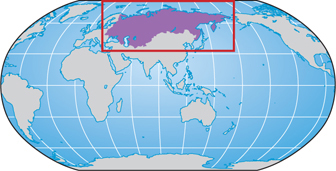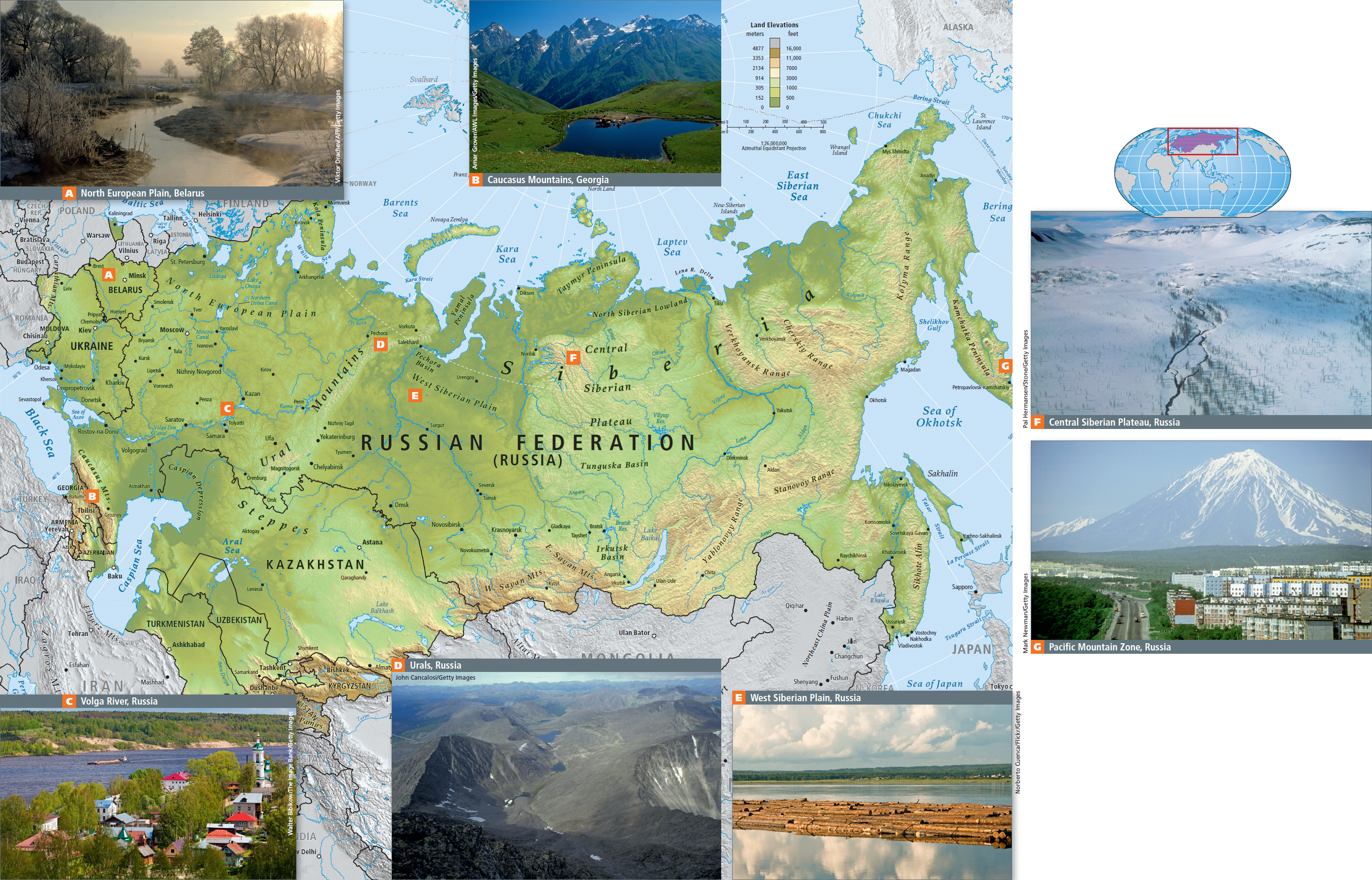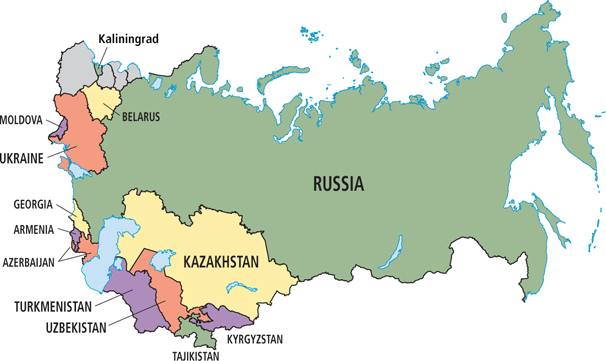5.1 Chapter 5 RUSSIA AND THE POST-SOVIET STATES
192
193

chapter 5
RUSSIA AND THE POST-
194
GEOGRAPHIC INSIGHTS
After you read this chapter, you will be able to discuss the following issues as they relate to the five thematic concepts:
|
1. |
Environment: |
Economic development has taken precedence over environmental concerns in Russia and the post- |
|
2. |
Globalization and Development: |
After the fall of the Soviet Union, economic reforms and globalization changed patterns of development in this region. Wealth disparity increased and jobs were lost as many Communist- |
|
3. |
Power and Politics: |
This region has a long history of authoritarianism. While there is some pressure to expand political freedoms, there are still few opportunities for the public to influence the political process. Elected representative bodies often act as rubber stamps for very strong presidents and exercise only limited influence on policy making. |
|
4. |
Urbanization: |
A few large cities in Russia and Central Asia are growing fast, fueled by the expansion of energy exports. Elsewhere, many cities are suffering from a lack of investment and maintenance as their economies struggle in the post- |
|
5. |
Population and Gender: |
Populations are shrinking in many parts of the region due largely to lower birth rates and declines in life expectancy. These changes relate to consistently high levels of participation by women in the workforce and to the economic decline in the 1990s that followed the collapse of the Soviet Union. Men and women have been affected differently in the post- |
The Russia and Post-Soviet States Region
Russia and the post-

The five thematic concepts are explored as they arise in the discussion of regional issues. Vignettes, such as the one below, illustrate one or more of the themes as they are experienced in individual lives.
GLOBAL PATTERNS, LOCAL LIVES
It is February 2012 and a cold, snowy day in Moscow, the capital of the Russian Federation. Tens of thousands of protesters hold hands to form an enormous circle around the city, along one of the traffic-
Putin had already served 8 years as president, from 2000 to 2008. Prevented by the constitution from running again for a third consecutive term, he had an ally become president for 4 years, after which Putin ran for a third and completely legal nonconsecutive term. Despite the efforts of Segupova, Venediktova, Pussy Riot, and other demonstrators, Putin is again serving as president of Russia after having decisively won the March 2012 election. The outcome of the election was hardly in doubt, due to the lack of other serious contenders for the presidency and Putin’s dominance in state media reporting.
195
On the face of it, these events suggest that the political status quo has been maintained and that power is still concentrated within a small group of elites who have little interest in the expansion of political freedoms. However, the upwelling of demonstrations indicates that the political landscape is slowly changing in Russia. A few months earlier, a contested election in Russia’s parliament, the Federal Assembly, also resulted in widespread protests by people who felt that the election had been rigged to ensure the victory of Putin’s party. After Putin’s election, protests continued in the streets and squares of central Moscow (Figure 5.2). In 2012, three members of Pussy Riot were put on trial and sentenced to prison for “hooliganism,” which has reinforced the suspicion among many that political dissent in Russia will be repressed by the authorities.

THINKING GEOGRAPHICALLY
Question 5.1
XN0RO31TBif1q5L1yQWplKUP8yjWEinezYlhQInAqmBIluSavEbYjMXWTOM78apaVsIAN6CwLvMq+DfKqcFBBVW5MZVhpPX3yQaaOC3w9XqTp0SpNk2gMg==As Russia slowly becomes wealthier, its people are demanding more political freedoms. This is especially true of the growing middle class, the urbanites in large cities (particularly those in Moscow and St. Petersburg), and the country’s youth. But so far, politicians like Vladimir Putin have the support of the majority of Russians, who perceive them as strong leaders. People in hardscrabble industrial cities, small towns, and rural areas, along with the elderly, view Putin as a force for stability, which is favored by many, considering the political turbulence Russia has had during the last two decades. Putin being reelected also has larger global geopolitical ramifications because the relationship between Russia and the West sometimes involves suspicion on each side and sometimes, when it suits both regions, is one of cooperation. [Sources: Christian Science Monitor, New York Times, and Sky News. For detailed source information, see Text Sources and Credits.]
Russia is the largest country in a region that has entirely changed its political and economic systems in a short period of time. Barely two decades ago, the Union of Soviet Socialist Republics (USSR), more commonly known as the Soviet Union, was the largest political unit in the world, stretching from Central Europe to the Pacific Ocean. It covered one-
Union of Soviet Socialist Republics (USSR) the multinational union formed from the Russian empire in 1922 and dissolved in 1991; commonly known as the Soviet Union
Soviet Union see Union of Soviet Socialist Republics
Politically, the Soviet Union has been replaced by a loose alliance known as the Commonwealth of Independent States. It consists of Russia and 11 independent post-

196
Geopolitically, this region is still sorting out its relationships. The Cold War between the Soviet Union and the United States and its allies is over. Most former Soviet allies in Central Europe have already joined the European Union, and some other countries in the region may eventually do the same. Trade with Europe, especially in oil and gas, is booming, if fraught with conflict. In the future, the Central Asian states currently allied with Russia may align themselves with neighbors in Southwest Asia or South Asia. The far eastern parts of Russia—

After 70 years of authoritarian rule, elections are becoming the norm throughout this region. Whether these are actually free and fair elections is debatable, as opposition candidates are marginalized by lack of access to both print and broadcast media. Meanwhile, an explosion of crime and corruption has many wondering if the new political systems of this region are strong enough to endure.
THINGS TO REMEMBER
Politically, the Soviet Union has been replaced by a loose alliance known as the Commonwealth of Independent States that consists of Russia and 11 independent post-
Soviet states. A process of geopolitical realignment is taking place, in which some post-
Soviet states seek closer relations with Europe, while others are developing ties with nearby Asian countries. However, most maintain strong ties with Russia, which dominates this region. Elections have become common in the region, although whether they are free and fair is uncertain. Political systems in the region are also threatened by crime and corruption.
What Makes Russia and the Post-
Russia and the post-
197
Terms in This Chapter
There is no entirely satisfactory new name for the former Soviet Union. In this chapter we use Russia and the post-
Russian Federation Russia and its political subunits, which include 21 internal republics